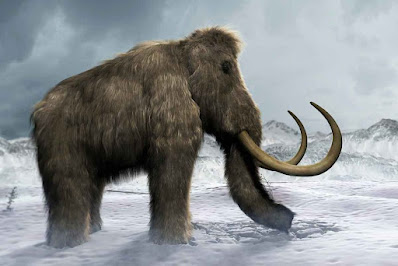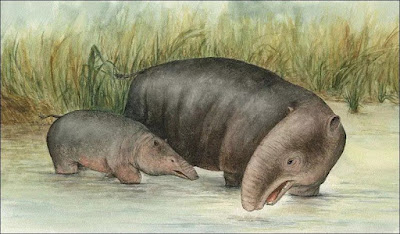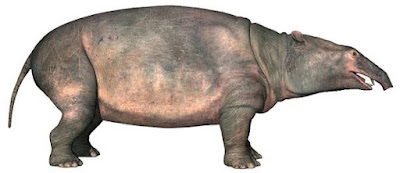Elephants are the largest land mammals that still survive today. Where these elephants are included as ancient animals from the last generation that can still survive in modern times, although currently their population in the wild has decreased dramatically.
Well on this occasion, I will give you a review about the ancient elephant species that you need to know. There are about 10 species of ancient elephants that have been revealed by scientists, what types of elephants are these? let's see the answer below.
1. American Mastodon
 |
| American Mastodon |
As the name implies, the American Mastodon used to inhabit the Americas. Its habitat is widespread from North America, from Alaska, the east coast of the United States to Mexico.
It is estimated that they lived in the Paleogene era, about 30 million years ago, said the ThoughtCo page. Now, you can only see the skeleton.
The height of the female elephant is 7 feet (2.1 meters) and the male is 10 feet (3 meters). It can weigh up to 6 tonnes, be up to 4.5 meters long and its tusks are up to 2 meters long, says the Canadian Museum of Nature.
The woolly mammoth tusk was more curved than the American Mastodon's. It is estimated that the American Mastodon went extinct 10,500 years ago.
2. Amebelodon
 |
| Amebelodon |
The most prominent feature of Amebelodon is the lower tusk that is shaped like a spade. These two tusks are flat, flat and close together.
Its function is to dig the soil and scrape the bark of trees, says the ThoughtCo website. Its habitat is in semi-aquatic areas and marshes in North America.
Amebelodon elephant lived in the Late Miocene era, between 10 million and 6 million years ago. It is about 6-10 feet (2-3 meters) long and weighs 1-2 tons.
Just like other ancient elephant species, Amebelodon was a herbivore and ate plants to survive.
3. Furry Mammoth
 |
| Furry Mammoth |
For this type of elephant, it may be familiar, because the Furry Mammoth is often used as an animal in a film, be it an animated film or a Hollywood film.
From this film, it is known that in ancient times there was a species of elephant that had thick fur and long curved tusks.
This woolly mammoth was last seen 4000 years ago on a remote island in the Arctic Ocean. It should be noted, if in the past, humans did live side by side with these mammoths, but unfortunately, early humans used to hunt these mammoths as food.
4. Deinotherium
 |
| Deinotherium |
In general, the tusks of these elephants are straight forward or curved upwards, but this Deinotherium species has its own uniqueness and is different from the general population. This elephant tusk actually curves down and tends to be short in size.
The original habitat of this Deinotherium is in the forests of Africa and Eurasia, they live in the Middle Miocene Era to the Modern Miocene which occurred about 10 million to 10,000 years ago. When compared to other ancient elephant species, this Deinotherium has the largest size.
This elephant has a length of about 16 feet (4.87 meters) and can weigh up to 4-5 tons. The body shape of this elephant is similar to that of a modern elephant, except for the tusks which are short, curved downwards, and blend into the jaws.
5. Palaeomastodon
 |
| Palaeomastodon |
Many scientists believe, if Palaemastodon is still a close relative of Moeritherium which became one of the ancestors of elephants. At first glance, the physical appearance of this animal resembles a tapir that exists in today's modern era.
This Palaemastodon lived in the late Eocene, which is about 35 million years ago and its natural habitat was in the swamps of northern Africa. As for its size, this Palaemastodon has a height of about 2.2 meters, a length of 4 meters, and a weight of 2.5 tons.
What makes this elephant different is that this animal has 3 small ears located on the top to ensure it stays dry. The tusks of this type of elephant tend to be short, and the bottom tusk has a spade-like shape that is useful for dredging plants from river banks or lake bottoms.
6. Stegomastodon
 |
| Stegomastodon |
For the next elephant species, this time named Stegomastodon, at first glance the shape of this animal resembles a modern elephant that we often know, but what distinguishes this type of elephant is the longer size of the tusks of Stegomastodon.
This animal lived in the late Pliocene to modern times, about 3 million to 10,000 years ago. This Stegomastodon's natural habitat was in North and South America, where this animal had a height of 2.6 meters, a length of 4 meters, and a weight of 4.7 tons.
This Stegomastodon tusk has a length of 3.5 meters, which for this size is relatively short than the types of elephants in the world that still exist today, with an average length of 4 to 5 meters.
7. Platybelodon
 |
| Platybelodon |
At first glance, Platybelodon looks similar to Amebelodon because they both have flat tusks at the bottom that look like spades. In fact, the shape of the two faces are different. Platybelodon's face was flatter, flat and oval, while Amebelodon's face was slightly similar to the modern elephant we know today.
They lived in the Late Miocene, about 10 million years ago, according to the ThoughtCo website. Platybelodon used to live in swamps, lakes and rivers in Eurasia and Africa. The tusk, which is shaped like a shovel, is useful for digging soil, cutting hard tree bark and finding vegetation in rivers.
8. Barytherium
 |
| Barytherium |
If this type of elephant is very similar to a but, but they are Barytherium which is a combination of a hippopotamus and an elephant. Barytherium is one of the ancestors of the earliest elephants.
They lived in the late Eocene to early Oligocene, about 40-30 million years ago. And this Barytherium became a forest dweller of Africa, such as Libya, Oman, and Egypt.
When viewed in more detail, this animal has two pairs of tusks in the lower and upper jaws, these tusks appeared due to adaptation to food, it is estimated that they are 3 meters long and weigh 1-2 tons.
9. Moeritherium
You may not believe that this animal is an elephant. Because, his appearance looks like a mix of hippos, tapirs and wild boars. This uniquely shaped ancient elephant lived in the Late Eocene era, to be precise around 37-35 million years ago. It is only 8 feet (2.4 meters) long, 70 cm high and weighs only 235 kilograms. Quite small and light!
From the shape of the skull, Moeritherium does not have the characteristics of an elephant. There is no long trunk, only a flexible upper lip like a tapir. The shape of its teeth is more like a tapir than an elephant. Previously, Moeritherium lived in swampy areas of northern Africa, says the ThoughtCo website.
10. Phiomia
 |
| Phiomia |
Lastly, Phiomia is an ancient elephant with a unique shape. Their bodies may have resembled modern elephants, but they had very short trunks with four tiny tusks on the upper and lower jaws, the Extinct Animals page says. This ancient elephant used to live throughout Africa and Eurasia, around 37-30 million years ago.
It is estimated that Phiomia is 10 feet (3 meters) long and weighs 500 kg. The fossils found are very limited, scientists only found a set of upper and lower teeth and a limited part of the skeleton. Anyway, even though the tusks are small, they are useful for shoveling weeds off the ground and defending themselves from predators.
Well, that's 10 ancient elephants that have become extinct which have a unique and different shape from the elephants we know today. Don't worry, you can still see the fossils and skeletons in the museum!
